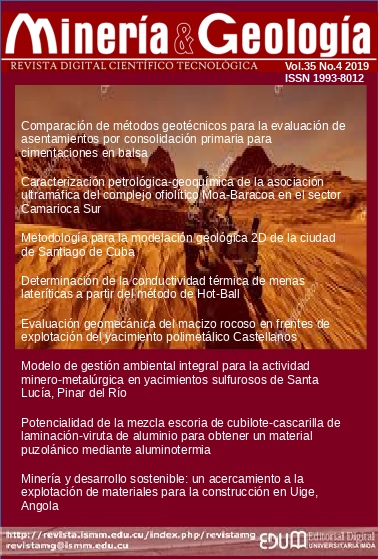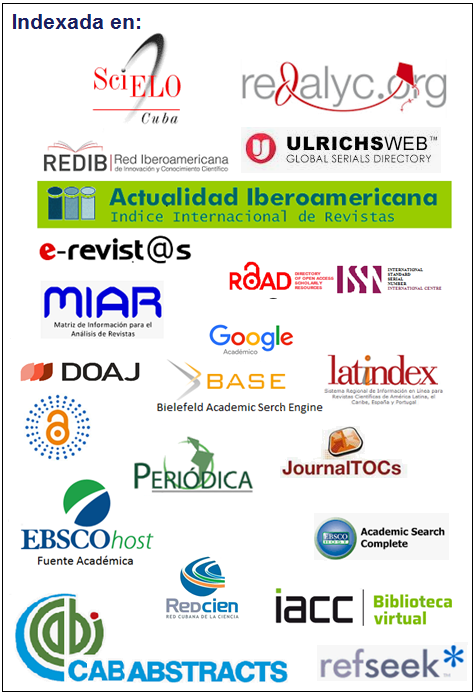Rock mass geomechanical assessment on exploitation areas of Castellanos polymetallic deposit
Keywords:
geomechanical assessment, polymetallic, Castellanos deposit, opencast mining.Abstract
The purpose of this study was to assess the geomechanical quality of the rock mass from Castellano polymetallic deposit in Pinar del Río province from the analysis of three mining fronts. DIP software V.6.0 was used when checking the jointing for determining the routes of main crack systems. 3D model of each front was obtained by using GEMCOM v 6.5. The quality of the solid was established based on RQD and RMR indices from Beniawski methodology. As a result, three families of predominant cracks and natural blocks of small sizes to medium with cubic, elongated and tabular shapes were identified, rock mass was generally classified as medium quality. The existence of slate rocks diminishes the geomechanical quality of the solid due to their characteristics.Downloads
References
Bieniawski, Z. T. 1989: Engineering rock mass classification: a complete manual for engineers and geologists in mining, civil, and petroleum engineering. John Wiley & Sons. ISBN 0-471-60172-1.
Cartaya-Pire, M. 2006: Caracterización geomecánica de macizos rocosos en obras subterráneas de la región oriental de país (resumen de tesis doctoral). Minería y Geología, 22(3): 56 p. ISSN: 0258 5979.
Cuni-Calzada, J. 2015: Aprovechamiento integral de las areniscas intemperizadas del yacimiento Castellanos. Lastra-River José Francisco (Tutor). Tesis de maestría. Universidad de Pinar del Río Hermano Saiz Montes de Ocas. Cuba. 97 p.
Dos-Santos, D. M. y Guardado-Lacaba, R. 2012: Evaluación de las propiedades geotécnicas de las rocas y suelos en el complejo minero kimberlítico de Catoca (Angola). Minería y Geología, 28(3): 1-17. ISSN: 1993 801.
Díaz-Carmona, A. y Estrada-Núñez, N. 2011: Estimación de recursos y reservas del yacimiento polimetálico Castellanos. Pinar del Río, Cuba.
Empresa Minera del Caribe (EMINCAR). 2017: Proyecto de la Concesión de Explotación y Procesamiento Castellanos. Pinar del Rio, Cuba.
International Society for Rock Mechanics (ISRM). 1981: Rock Characterizations Testing and Monitoring. Oxford: Pergamon Press. 211 p.
Jordá-Bordehore, L.; Jordá-Bordehore, R.; Durán-Valsero, J. J. y Romero-Crespo, P. L. 2017: Evaluación de la estabilidad de las labores y pilar corona en las minas abandonadas de S'Argenera (Ibiza, España) combinando clasificaciones geomecánicas, métodos empíricos y análisis numérico, enfocado a su posible aprovechamiento turístico. Boletín geológico y minero, 128(1): 3-24. ISSN: 0366-0176.
Miranda–Castro, G. A. y Niño-Florez, C. M. 2016: Evaluación geológica, caracterización geomecánica y cálculo de recurso de roca caliza para el Contrato de Concesión Minera OG2-100 11 en la vereda Las Monjas del municipio de Firavitoba. Trabajo de pregrado. Universidad Pedagógica y Tecnológica de Colombia. 82 p. Consulta: 25/04/2018. Disponible en: http://repositorio.uptc.edu.co/handle/001/1683.
Palmstrom, A. 1982: The volumetric joint count―a useful and simple measure of the degree of rock mass jointing. In: International Association of Engineering Geology. International congress 4: 221-228. New Delhi, India.
Palmstrom, A. 1995: RMi –a rock mass characterizations systems for rock engineering purposes. PhD thesis. University of Oslo. 405 p.
Palmstrom, A. 1998: Caracterización de macizos rocosos mediante el Rmi y sus aplicaciones en Mecánica de Rocas. Ingeotúneles: Carlos López Jiménez. Madrid. T–II, p. 79–107.
Palmstrom, A. 2005: Measurements of and correlations between block size and rock quality designation (RQD). Tunnelling and Underground Space Tchnology, 20(4): 362-377.
Published
How to Cite
Issue
Section
Copyright (c) 2019 Helder Vemba Mucuta-Lito, Maday Cartaya-Pires, Julio Cuni-Calzada

This work is licensed under a Creative Commons Attribution-NonCommercial 4.0 International License.
- Authors retain copyright and guaranteeing the right magazine to be the first publication of the work as licensed under a Creative Commons Attribution-NonCommercial that allows others to share the work with an acknowledgment of the work's authorship and initial publication in this journal.
- Authors may establish separate supplemental agreements for the exclusive distribution version of the work published in the journal (eg, place it in an institutional repository or publish it in a book), with an acknowledgment of its initial publication in this journal.
- Authors are allowed and recommended to disseminate their work through the Internet (e.g., in institutional telematic archives or on their websites) before and during the submission process, which can produce interesting exchanges and increase citations of the published work. (See The effect of open access)




